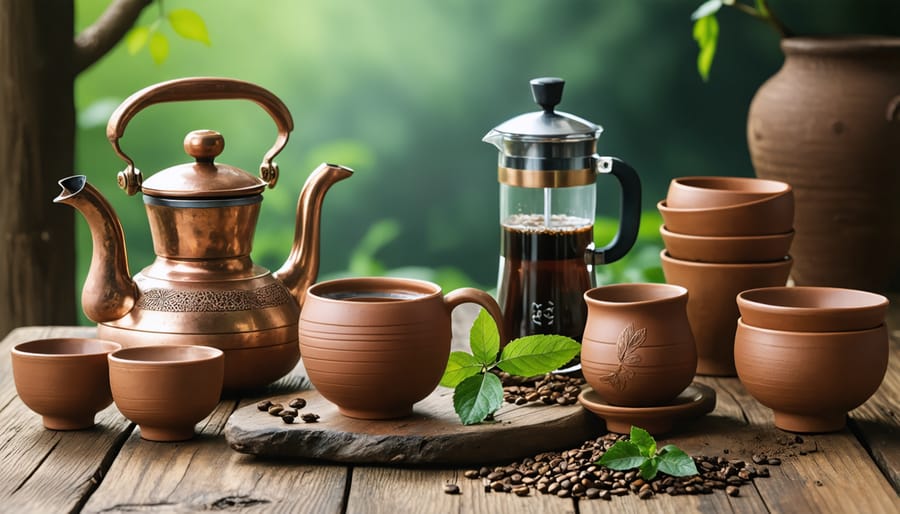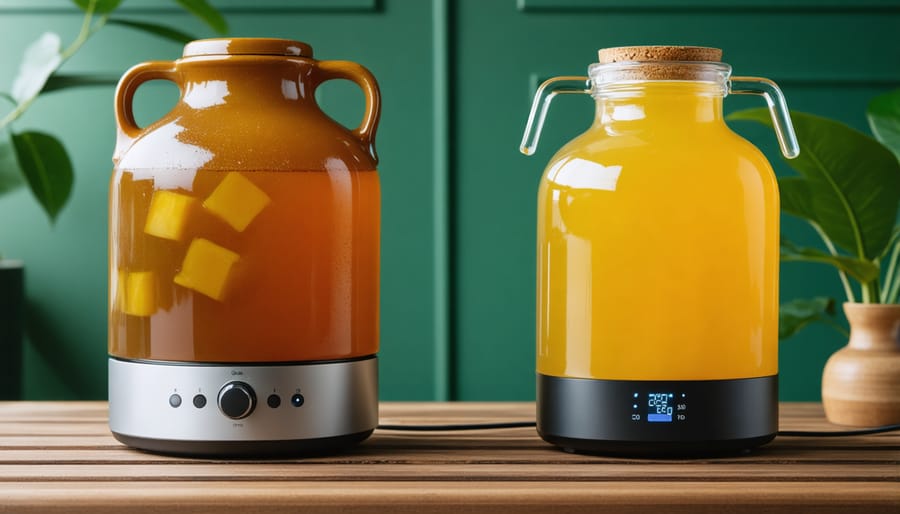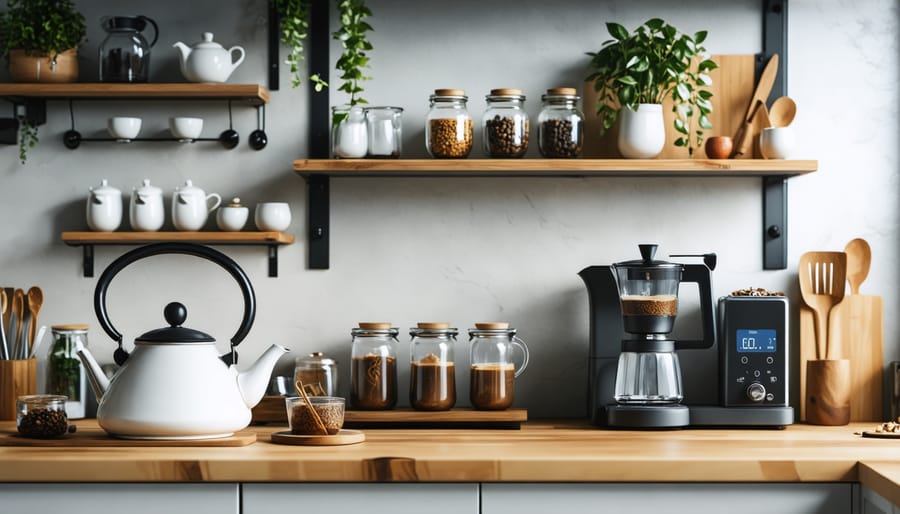
Traditional beverages hold a sacred place in our cultural heritage, weaving stories of ancestral wisdom and time-honored craftsmanship into every carefully prepared sip. From the ceremonial matcha whisked in Japanese tea houses to the rich Ethiopian coffee ceremonies that bring communities together, these drinks represent far more than mere refreshment – they’re living traditions that connect us to our roots.
Today’s modern kitchens might seem worlds away from the earthen pots and hand-carved gourds of our ancestors, but the soul of traditional beverage-making remains unchanged. Whether you’re drawn to the meditative process of brewing kombucha or the precise art of crafting the perfect chai, there’s something deeply satisfying about preserving these ancient practices while thoughtfully incorporating contemporary conveniences.
As someone who’s spent years exploring the delicate balance between authenticity and accessibility, I’ve discovered that maintaining traditional methods doesn’t mean rejecting modern innovations entirely. Instead, it’s about understanding which elements are essential to preserve and where gentle adaptations can make these beloved beverages more approachable for today’s busy lifestyle.
Let’s explore how to honor these time-tested techniques while creating a practical setup that fits seamlessly into your modern home, ensuring these precious traditions continue to thrive for generations to come.
The Art of Traditional Beverage Making
Time-Honored Techniques Worth Preserving
In my years of exploring traditional beverage-making, I’ve discovered that some age-old techniques simply can’t be replicated by modern shortcuts. Take the gentle art of hand-whisking matcha, for instance – there’s something almost meditative about the ritual that electric frothers just can’t capture. The same goes for the slow, patient process of cold-brewing tea, where time itself becomes an essential ingredient.
I’ve found that hand-grinding coffee beans preserves delicate aromatics that can be lost with electric grinders, which can heat the beans during processing. The traditional method of using a clay pot for brewing certain herbal teas actually enhances the flavor profile, as the porous material interacts with the brew in ways that steel or glass cannot.
Even something as simple as hand-squeezing citrus for beverages yields better results than store-bought juices. The oils from the peel naturally infuse into the juice, creating a more complex and vibrant flavor. These time-tested methods might take a little more effort, but they connect us to centuries of beverage crafting wisdom while delivering superior results that our ancestors knew best.
Why Traditional Methods Matter Today
In our fast-paced world of instant gratification, there’s something deeply meaningful about taking the time to craft beverages the traditional way. As someone who discovered the joy of slow brewing through my grandmother’s cherished tea ritual, I’ve come to appreciate how these time-honored methods connect us to our roots while delivering unmatched quality and flavor.
Traditional beverage-making isn’t just about nostalgia; it’s about understanding the fundamental principles that create exceptional drinks. When we embrace sustainable beverage making techniques, we often find that our ancestors knew best. Hand-grinding coffee beans releases oils more evenly than electric grinders, while naturally fermenting kombucha allows beneficial cultures to develop at their own perfect pace.
These methods also offer a mindful break from our hectic routines, creating moments of peace and intention in our daily lives. Whether you’re steeping loose-leaf tea in a traditional pot or slowly filtering cold brew through cotton, these practices remind us that sometimes the journey is just as rewarding as the destination. Plus, many traditional methods actually produce better results, with more complex flavors and richer aromas than their modern counterparts.
Essential Traditional Equipment
Tea and Coffee Brewing Essentials
There’s something truly special about brewing beverages the traditional way – it’s like a ritual that connects us to generations past. I remember watching my grandmother carefully prepare her morning tea using her cherished ceramic teapot, and that memory still inspires my own brewing routine today.
For tea enthusiasts, essential equipment includes a proper teapot (ceramic or cast iron works beautifully), a tea strainer for loose leaves, and a set of cups that feel just right in your hands. My personal favorite is a Japanese-style cast iron teapot, which retains heat wonderfully and develops a unique character over time.
Coffee lovers will want to explore traditional brewing methods like the French press, pour-over dripper, or the timeless stovetop moka pot. Each brings out different qualities in your coffee beans. Don’t forget a quality grinder – freshly ground beans make all the difference in your final cup.
Temperature control is crucial for both beverages. A gooseneck kettle gives you precise control over water flow and temperature, while a traditional thermometer helps achieve the perfect brewing temperature. Tea and coffee scales might seem fancy, but they help maintain consistency in your brewing routine.
Remember, these tools aren’t just functional – they’re conversation pieces that make your daily brewing ritual more meaningful and enjoyable. Start with the basics and gradually build your collection as you discover what speaks to your personal brewing style.

Fermentation and Infusion Tools
Let’s dive into my favorite part of traditional beverage-making – the beautiful tools that make it all possible! As someone who’s been crafting kombucha and herbal infusions for years, I’ve learned that having the right equipment makes all the difference in mastering various infusion techniques.
The heart of any fermentation setup is a large glass jar or vessel – I recommend at least a one-gallon size for kombucha brewing. Avoid metal or plastic containers, as they can interfere with the fermentation process. A breathable cloth cover and rubber band are essential for keeping out dust while allowing airflow.
For kefir-making, you’ll want a wide-mouth mason jar and a plastic strainer (metal can damage the grains). Tea enthusiasts should invest in a good-quality glass teapot with a removable infuser basket – this allows your herbs and tea leaves to expand fully while steeping.
My must-have tools include:
– pH testing strips for monitoring fermentation
– Natural fiber tea bags for custom blends
– A long-handled wooden spoon for gentle stirring
– Glass bottles with tight-fitting lids for second fermentation
– A temperature strip or thermometer
Remember, while these tools are important, many of our ancestors made wonderful beverages with much simpler setups. Start with the basics and expand your collection as your practice grows.

Modern Artisan Equipment Innovations
Temperature Control and Precision
Remember when making the perfect cup of tea meant guessing the water temperature and hoping for the best? I certainly do! These days, we’re fortunate to have amazing tools that take the guesswork out of beverage preparation while honoring traditional methods.
Temperature-controlled kettles have revolutionized how we prepare traditional beverages. With precise digital controls, you can select the exact temperature needed for your drink – whether it’s a delicate green tea at 175°F or a robust coffee at 200°F. I love how these modern marvels maintain the temperature, letting you focus on other preparation steps without worrying about over-heated or cooling water.
Smart thermometers are another game-changer. These sleek devices help you monitor temperatures throughout the brewing process, ensuring consistency in every batch. For those of us who make kombucha or other fermented drinks, these tools are especially valuable for maintaining the perfect environment for our cultures.
What I particularly appreciate about these modern tools is how they help preserve traditional techniques while making them more accessible. They’re like having a knowledgeable mentor guiding you through each step. Many of my readers tell me they feel more confident experimenting with different beverages now that they have reliable temperature control.
The best part? These tools are becoming increasingly user-friendly and affordable, making it easier than ever to create cafe-quality traditional beverages at home.
Time-Saving Innovations
I remember when my grandmother would spend hours in the kitchen preparing our family’s traditional beverages, and while I cherish those memories, I’m grateful for the innovative tools that help us preserve these customs without sacrificing our precious time.
Today’s market offers brilliant solutions that honor traditional methods while making the process more efficient. Electric tea kettles with precise temperature control ensure perfect steeping every time, while programmed settings remember your preferred brewing times. Modern stone mills maintain the authentic grinding process for matcha but require far less physical effort than their ancient counterparts.
One of my favorite innovations is the automated tea infuser, which mimics the traditional multiple-steeping process while allowing you to multitask. Smart coffee makers with built-in grinders preserve the freshness of whole beans while streamlining your morning routine. For those who love traditional cold-brew methods, new slow-drip systems maintain the same careful extraction process but with easier setup and cleanup.
The beauty of these innovations lies in their thoughtful design – they’re created to enhance, not replace, time-honored techniques. Many feature traditional materials like ceramic and bamboo alongside modern technology, creating a perfect bridge between past and present. These tools allow us to maintain our connection to traditional beverage-making while fitting seamlessly into our busy modern lives.
Remember, embracing these time-saving innovations doesn’t mean abandoning tradition – it means making these precious customs more accessible for future generations to enjoy.
Creating Your Perfect Setup
Essential Starter Equipment
Starting your journey into traditional beverage-making doesn’t have to be overwhelming! I remember feeling a bit lost when I first began, but I quickly learned that having the right basic tools makes all the difference. Whether you’re planning to craft non-alcoholic beverages or exploring other traditional drinks, here’s your essential starter kit.
First, invest in a quality large pot or kettle – ideally, one that holds at least 2-3 liters. I suggest stainless steel for its durability and ease of cleaning. You’ll also need a reliable strainer or fine-mesh sieve to remove any ingredients or sediment from your beverages.
A set of measuring tools is absolutely crucial. Include both dry and liquid measuring cups, plus a set of measuring spoons for precise portions. Trust me, this makes a huge difference in achieving consistent results!
Don’t forget about storage solutions. Pick up a few glass bottles or jars with tight-fitting lids. I prefer clear glass because it lets you monitor the color and clarity of your beverages. Mason jars work wonderfully and add a lovely rustic touch to your kitchen.
A long-handled wooden spoon and a funnel are also must-haves. The wooden spoon won’t react with acidic ingredients, and the funnel helps prevent those dreaded spills when transferring liquids.
Lastly, consider a basic thermometer – it’s especially helpful when working with temperature-sensitive ingredients like tea leaves or when fermenting traditional drinks. These tools might seem simple, but they’re the foundation of creating beautiful, traditional beverages at home.

Scaling Up Your Collection
As your collection of traditional beverages grows, you might find yourself ready to invest in some quality equipment that makes the process more enjoyable and efficient. I remember when I first upgraded from my basic setup – it was like discovering a whole new world of possibilities!
For tea enthusiasts, consider investing in a temperature-controlled electric kettle. Being able to heat water to precise temperatures really makes a difference in bringing out those subtle flavors, especially for delicate green teas. A high-quality ceramic teapot with a built-in filter is another game-changer, allowing you to brew loose-leaf teas with ease while maintaining their authentic character.
If you’re passionate about coffee, a burr grinder is worth every penny. The uniform grind size it produces creates consistently delicious cups, whether you’re using a pour-over, French press, or traditional coffee pot. Speaking of which, a copper Turkish coffee pot (cezve) is a beautiful addition that lets you explore centuries-old brewing methods.
For those who love fermenting beverages, a set of glass fermentation vessels with airlocks will help you craft kombucha and other probiotic drinks more reliably. Temperature strips and a quality pH meter are invaluable tools for monitoring your ferments.
Don’t forget about storage solutions! Airtight glass containers with UV protection keep your ingredients fresh longer, while a dedicated beverage cabinet or cart can transform a corner of your kitchen into an inspiring preparation space. Many of my readers have shared how creating this special spot has turned their daily beverage ritual into a moment of mindful self-care.
Remember, building your collection gradually allows you to appreciate each new addition while developing your skills along the way.
As we embrace the fast-paced nature of modern life, it’s heartening to see how traditional beverage-making methods continue to hold their charm and relevance. I’ve found that striking the perfect balance between time-honored techniques and contemporary convenience doesn’t mean sacrificing authenticity – it’s about creating harmony between the old and the new.
In my own journey of exploring traditional beverages, I’ve discovered that modern tools can actually enhance our appreciation for ancient practices. Whether it’s using a programmable tea kettle to achieve the perfect temperature for delicate green teas or incorporating a digital scale for precise measurements in traditional coffee preparation, these innovations help us maintain consistency while honoring traditional methods.
The beauty lies in how we can preserve the essence of traditional beverages while adapting to our modern lifestyle needs. Many of us have morning routines that blend centuries-old rituals with time-saving techniques, creating meaningful moments in our busy days. This fusion approach has made traditional beverages more accessible to a new generation of enthusiasts, ensuring these precious practices continue to thrive.
Remember, embracing modern convenience doesn’t diminish the authenticity of traditional beverages – it simply makes them more achievable in our contemporary lives. By maintaining this balance, we can continue to enjoy and share these cherished traditions while making them relevant for years to come.



